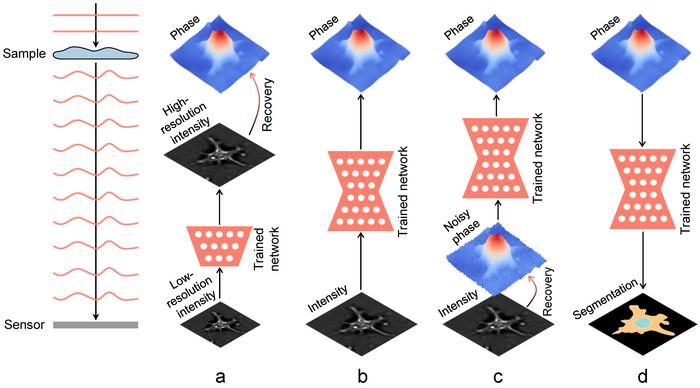Amplitude and phase are the two fundamental components of light, an electromagnetic field. However, due to their low sampling frequency, optical detectors—which often rely on photon-to-electron conversion—such as charge-coupled device sensors and the human eye, are unable to record the phase of the light field.
 (a) Deep-learning-pre-processing for phase recovery. (b) Deep-learning-in-processing for phase recovery. (c) Deep-learning-post-processing for phase recovery. (d) Deep learning for phase processing. Image Credit: Kaiqiang Wang, Li Song, Chutian Wang, Zhenbo Ren, Guangyuan Zhao, Jiazhen Dou, Jianglei Di, George Barbastathis, Renjie Zhou, Jianlin Zhao, and Edmund Y. Lam
(a) Deep-learning-pre-processing for phase recovery. (b) Deep-learning-in-processing for phase recovery. (c) Deep-learning-post-processing for phase recovery. (d) Deep learning for phase processing. Image Credit: Kaiqiang Wang, Li Song, Chutian Wang, Zhenbo Ren, Guangyuan Zhao, Jiazhen Dou, Jianglei Di, George Barbastathis, Renjie Zhou, Jianlin Zhao, and Edmund Y. Lam
Luckily, the phase delay produces changes in the amplitude distribution as the light field propagates. This allows researchers to record the propagating light field’s amplitude and subsequently compute the associated phase, or phase recovery.
Holography/interferometry, Shack-Hartmann wavefront sensing, transfer of intensity equation, and optimization-based techniques (phase retrieval) are a few popular techniques for phase recovery. Regarding application range, computational complexity, and spatiotemporal resolution, they each have their drawbacks.
Recent years have seen extraordinary performance in phase recovery of deep learning, which is generally realized through deep neural networks, as a significant step towards true artificial intelligence (AI).
Researchers from The University of Hong Kong, Northwestern Polytechnical University, The Chinese University of Hong Kong, Guangdong University of Technology, and Massachusetts Institute of Technology examined several deep learning phase recovery techniques from the following four perspectives in a recent review paper that was published in Light Science & Application:
- Phase recovery using deep learning and pre-processing: Prior to phase recovery, the neural network applies several pre-processing operations to the intensity measurement, including pixel super-resolution, noise reduction, hologram creation, and autofocusing.
- Deep learning-in-processing for phase recovery: using supervised or unsupervised learning modes, the neural network either completes phase recovery directly or collaborates with the physical model or physics-based algorithm to complete phase recovery.
- Deep learning-post-processing for phase recovery: Following phase recovery, the neural network carries out post-processing operations such as phase unwrapping, noise reduction, resolution improvement, and aberration correction.
- Deep learning for phase processing: the neural network applies certain functions, for imaging modal transformation, segmentation, and classification, to the recovered phase.
Deep learning not only provides previously unheard-of benefits when used in phase recovery procedures, but it also has some unanticipated concerns. Even while several techniques could have the same appearance, there are subtle variances that can be missed.
These researchers highlight the distinctions and interrelationships among certain comparable techniques and offer recommendations for optimizing the use of physical models and deep learning in phase recovery.
The researchers stated, “It should be noted that the uPD (untrained physics-driven) scheme is free from numerous intensity images as a prerequisite, but requires numerous iterations for each inference; while the tPD (trained physics-driven) scheme completes the inference only passing through the trained neural network once, but requires a large number of intensity images for pretraining.”
They further added, “zf is a fixed vector, which means that the input of the neural network is independent of the sample, and therefore the neural network cannot be pre-trained like the PD approach.”
They concluded, “Learning-based deep neural networks have enormous potential and efficiency, while conventional physics-based methods are more reliable. We thus encourage the incorporation of physical models with deep neural networks, especially for those well modeling from the real world, rather than letting the deep neural network perform all tasks as a black box.”
Journal Reference:
Wang, K., et. al. (2023) On the use of deep learning for phase recovery. Light Science & Applications. doi:10.1038/s41377-023-01340-x